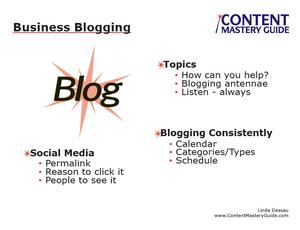If you want to receive all of my latest posts by email, click here to subscribe to the weekly Blogging Tips newsletter.
Small business owners constantly tell me that blogging and social media are just too much work. The goal of this blog and my training workshops is to pass along tips and techniques that help you make the most of your time and get the best results from your efforts.
I also want to empower you to make decisions about what and how to outsource to others. In a three-part series for SteamFeed, I interviewed social media strategist Brooke Ballard of B Squared Media about the 3 Cs of social media, and how you can automate or outsource these tasks.
I shared a description of the first article in an earlier post. Here’s a quick link in case you missed it: How to Manage the 3 Cs of Social Media, Part One
If you want to receive all of my latest posts by email, click here to subscribe to the weekly Blogging Tips newsletter.
How to Manage the Flow of Social Media Conversation – The 3 Cs, Part Two
 With so many other moving pieces to manage in a business, it can be difficult to keep up with the conversation on social media.
With so many other moving pieces to manage in a business, it can be difficult to keep up with the conversation on social media.
In the second part of my interview with Brooke Ballard of B Squared Media, we delved into how and when to outsource or automate conversation on social media. (Hint: Never automate conversation!)
http://www.steamfeed.com/manage-flow-social-media-conversation-3-cs-part-two/
How to Curate Content for Your Business on Social Media – The 3 Cs, Part Three
 In between posting your own content and having conversations, curating content from other experts rounds out your social media marketing strategy.
In between posting your own content and having conversations, curating content from other experts rounds out your social media marketing strategy.
To understand curation, Brooke Ballard from B Squared Media suggests you think of yourself as a librarian, not an author. Read more in Part Three of this series for SteamFeed.
http://www.steamfeed.com/curate-content-business-social-media-3-cs-part-three/
 Effective business blogging requires you to plan and create content that is relevant, meaningful and helpful to your audience. Behind the scenes, however, there are many other tasks that ensure your post will do its job of effectively attracting new customers for your business. Luckily, you don’t have to do all of them yourself!
Effective business blogging requires you to plan and create content that is relevant, meaningful and helpful to your audience. Behind the scenes, however, there are many other tasks that ensure your post will do its job of effectively attracting new customers for your business. Luckily, you don’t have to do all of them yourself! Being active on social media can seem like a lot of work. Many business owners wonder how much they can automate or outsource without being robotic or fake. In Part One of a
Being active on social media can seem like a lot of work. Many business owners wonder how much they can automate or outsource without being robotic or fake. In Part One of a 
 In this series about
In this series about  Jeff Korhan, MBA, is the author of Built-In Social: Essential Social Marketing Practices for Every Small Business (Wiley 2013).
Jeff Korhan, MBA, is the author of Built-In Social: Essential Social Marketing Practices for Every Small Business (Wiley 2013). In this post we’ll get back to my interview with expert video marketer Anthony Idle from
In this post we’ll get back to my interview with expert video marketer Anthony Idle from